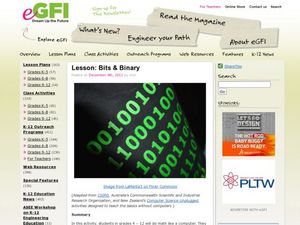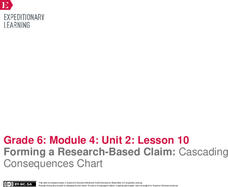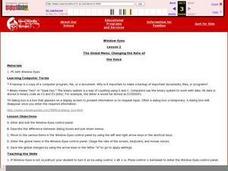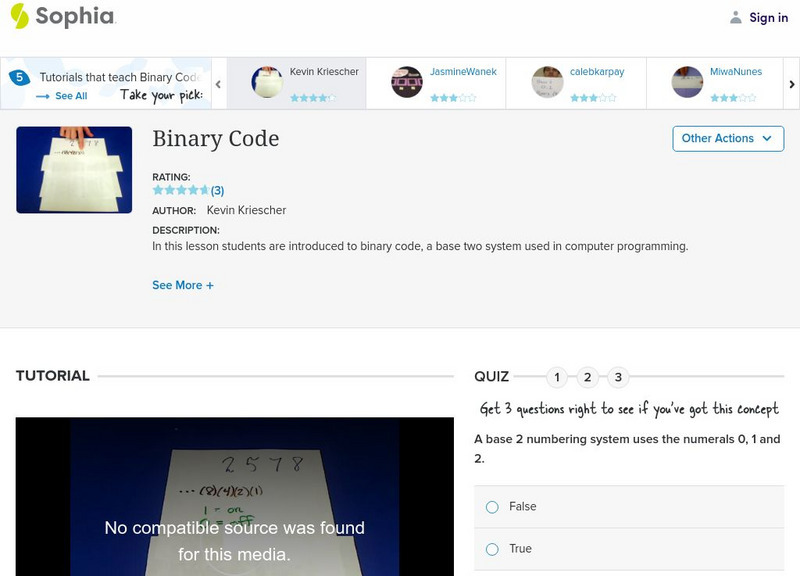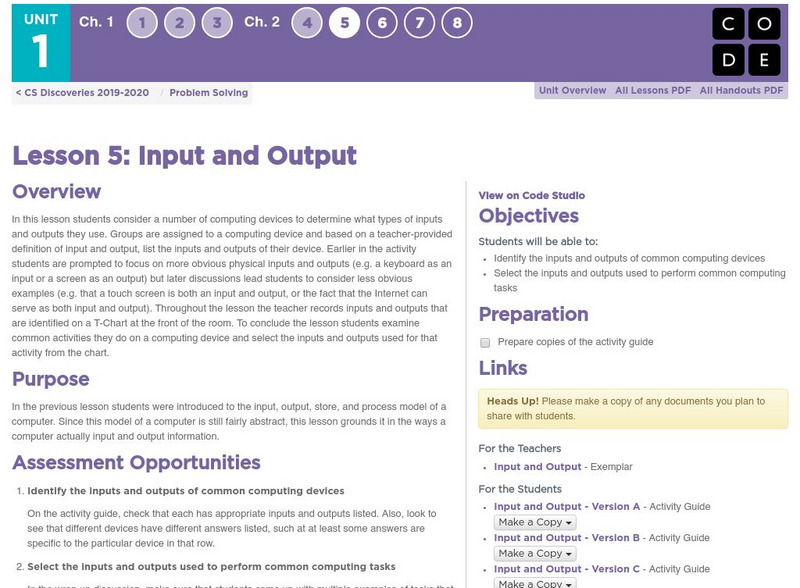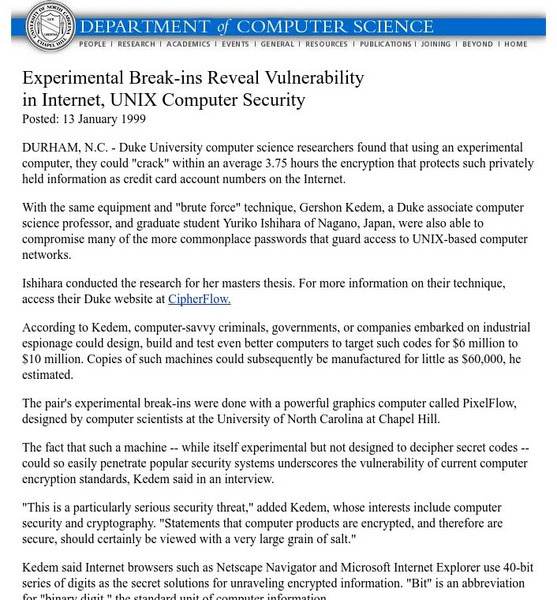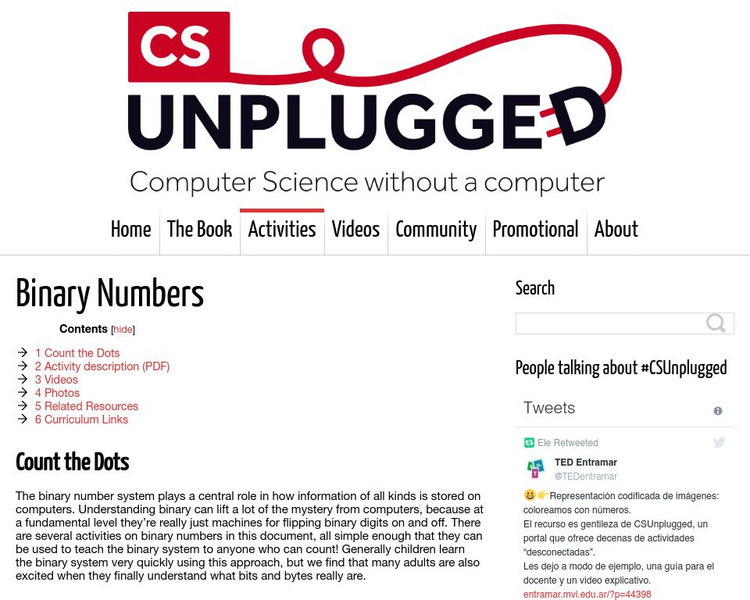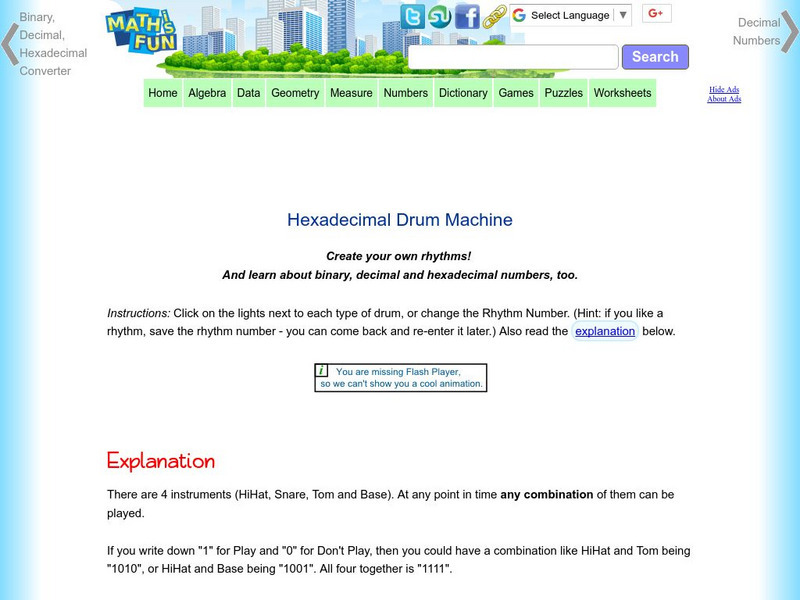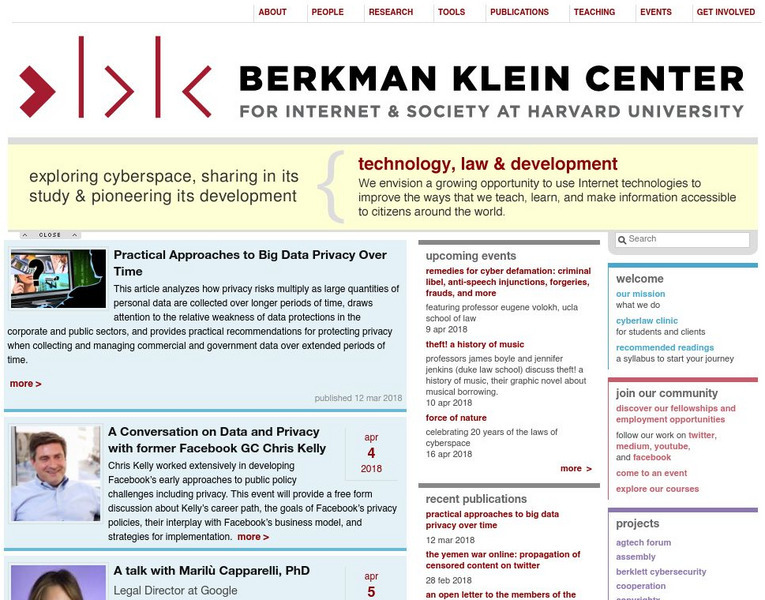eGFI
Bits & Binary
Youngsters love to write on their hands, and in this fabulous activity they are actually asked to. Using numbers written on the tips of their fingers, they will learn how the binary number system works. This hands-on activity is a...
Curated OER
Math: Number Systems
Pupils examine other number systems, particularly the binary number system. They discover how to convert from decimal to other base systems. Students analyze the advantages and disadvantages of using the coded decimals.
News Literacy Project
News Goggles: Identifying the News Source
A 25-slide presentation teaches viewers how to identify the source of stories in newspapers and online news sites. The slides show how to locate the byline where either the reporter's name or the wire service that provided the story can...
Media Smarts
Television Broadcast Ratings
Explore the relationships between programming, advertising, and the ensuing rating wars. Help develop the media smarts of your pupils through this examination of advertisers for popular shows. Although the included Sweep Chart features...
Curated OER
Zeros and Ones
Pupils review counting, the number system and the decimal number system. They rotate through three stations, "How RAM Works, "Binary Numbers" and "Binary Letters." They complete three separate worksheets to check for complete...
Media Smarts
Violence on Television
Focus on a specific incident of violence on television in the case of the Canadian Broadcast System showing Silence of the Lambs on public television. Look at the broadcasting codes and a complaint that was filed against the Association....
EngageNY
Forming a Research-Based Claim: Cascading Consequences Chart
Is it relevant? Scholars choose a resource from their folders and search for relevant information about the harmful and beneficial consequences of DDT. They mark benefits in one color and harmful effects with another color. They then add...
Curated OER
Colorful and Textured Backgrounds
Students create a solid color background for a web page. They calculate the hexadecimal code for a color value. They change the color of text and hypertext link items. They create a textured background from a graphic file.
Curated OER
ComSec for Network+: New Threats
Students identify the different types of security threats on a system. In this technology lesson plan, students demonstrate ways to defend the system from such attacks. They use computer simulation to implement security procedure.
Curated OER
Computer Language
A thorough and engaging slideshow presentation discusses all things computer, from artificial intelligence programs to text messaging lingo. Computer science students will get a kick out of the examples for ELIZA, Otto Jesperson's...
Curated OER
The Global Menu: Changing the Rate of the Voice
Young scholars examine the Windows-Eyes control panel by using dialog boxes, pull-down menus, left and right arrow keys, and shortcut keys. They also change the rate of the screen, keyboard, and mouse voices.
Curated OER
Chapter 9: Language Processing: Humans and Computers
Designed to accompany An Introduction to Language by Victoria Fromkin, Robert Rodman, and Nina Hyams, this powerpoint addresses a number of language, technological, and sociological topics. The slides could be helpful in either a...
Curated OER
Use of Lasers
Students explore the use of lasers. In this "lasers" science and career education instructional activity, students search the Internet to find uses for lasers and make a list of companies that use or produce lasers. Students complete a...
Sophia Learning
Sophia: Binary Code
The video lesson introduces students to the binary code. The concept is defined and examples are provided.
Other
Association for Computing Machinery: Acm Code of Ethics and Professional Conduct
The "Code of Ethics" from the American Association for Computing Machinery. Includes responsibility to employers, clients, system users, the profession, and society.
Math Is Fun
Math Is Fun: Binary Number System
Learn all about the binary number system and how to count in binary. Includes a set of practice questions.
TryEngineering
Try Engineering: Electric Messages: Then and Now
Lesson investigates electronic communication from the Morse Code system to text messaging. To learn about this, students construct simple circuits, send messages to each other, and explore the history and impact of communication.
Code.org
Code.org: Cs Fundamentals: Input and Output
Students consider a number of computing devices to determine what types of inputs and outputs they use.
University of North Carolina
University of North Carolina: Pixel Flow Code Cracking
This article reveals some techniques and vulnerabilities in Unix-based computer networks.
Other
Computer Tech. Doc. Project: Linux Op. System Background
This section of the website contains a large amount of information about Linux. It contains six documents on various aspects of Linux.
University of Canterbury
University of Canterbury: Cs Unplugged: Binary Numbers
With this lesson, educators can teach the binary system to anyone who can count. Using this approach, many adults are also excited when they finally understand what bits and bytes really are.
Math Is Fun
Math Is Fun: Hexadecimal Drum Machine
Create rhythms on this 4-instrument hexadecimal drum machine and see what your rhythms look like in the binary, decimal, and hexadecimal number systems.
Harvard University
Harvard University: Berkman Center for Internet and Society
This center is a research program founded to explore cyberspace by investigating the real and possible boundaries in cyberspace between open and closed systems of code, commerce, governance, and education, and the relationship of law to...
Math Is Fun
Math Is Fun: Binary Digits
Learn about the two binary digits, 0 and 1, and how they are combined to make numbers that correspond to our standard number system. Looks also at the relationship between binary and hexadecimal digits.
